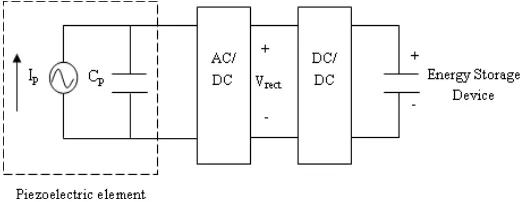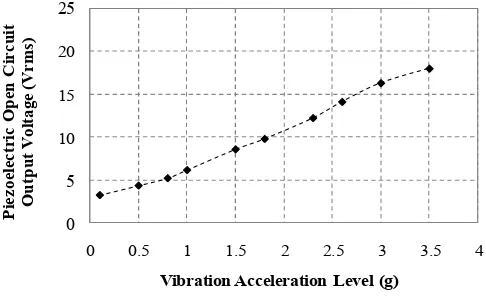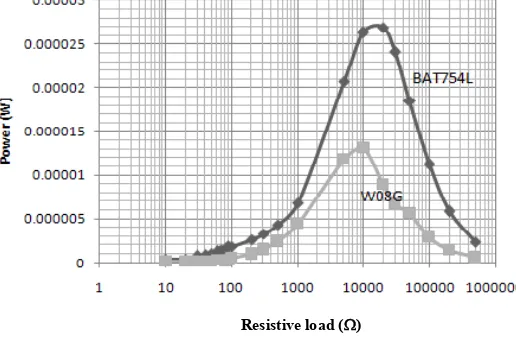IEEE Student Conference on Research & Development 2013
Experimental Comparison of Piezoelectric Rectifying
Circuits for Energy Harvesting
Ain Atiqa Mustapha, Noraini Mat Ali, and Kok Swee Leong,
Member, IEEE
Faculty of Electronic and Computer Engineering Universiti Teknikal Malaysia Melaka
Hang Tuah Jaya, 76100 Durian Tunggal, Melaka, Malaysia
Abstract- Piezoelectric energy harvester transforms mechanical
energy into electrical energy. However, the electrical output purely from the energy harvester needed to be conditioning before being use to power up small electronic devices. Output voltage in AC form will need to be rectified followed by stepping down using DC-DC converter to voltage level suit to any desired application. In this paper, an experimental was carried out to compare two different integrated circuit based rectifiers one of which is constructed using low voltage drop Schottky diodes, BAT754L and the other one is glass passivated single-phase bridge rectifier, W08G. It has been verified with experiment that Schottky diode outperformed normal diode type rectifying circuit.
I. INTRODUCTION
Energy harvesting using piezoelectric is one of the popular approaches to generate electrical energy from the conversion of low level ambient energy sources such as vibrations and human activities [1]. Due to its limited output power in the range of a few hundreds milliwatts, therefore it is applicable for small microelectronic system, which requires no battery and operates in a big number such as those deploy in wireless sensor network.
Piezoelectric energy harvesting is commonly associated to green technology as it can replace battery, that work toward the trend of small electronic device which is standalone and with greater mobility and less maintenance. Piezoelectric is well known in harvesting energy from ambient vibration sources. This is due to the fact that vibration is abundant around us as long as there is mechanical movement generated naturally or artificially, such as moving automobile as well as those generated from home appliances and industrial machineries [2]. However, one of the major concerns for piezoelectric based energy harvesting system is the power conditioning circuit.
When vibration is excited on piezoelectric material usually constructed in the form of a cantilever [3], it will transform kinetic energy into AC output voltage. This AC output voltage need to be rectified, DC-to-DC step down and stored before supplying to external electric load as shown in Fig.1. Beside that a more complex interfacing circuit involving inductor was reported to be able to improve the efficient of piezoelectric energy harvesting [4]. However, in this paper, we focus on the comparison on the performance of rectifying circuits
constructed with low voltage drop Schottky diodes, and conventional diodes.
Fig. 1 The schematic for the concept of a piezoelectric energy harvesting system
II. RECTIFIER AND INTERFACING CIRCUIT FOR
PIEZOELECTRIC ENERGY HARVESTER
The demand of low loss electronic circuit and high efficiency have been always the basic requirement for piezoelectric energy harvesting circuit due to its low level electrical output generation with output voltage in the range of a few volt while output current in the range of a few A.
There is a series of stages that involve in extracting electrical energy from vibration source as shown in Fig. 2. AC output voltage generated by piezoelectric when excited by vibration source, is rectified and followed by DC-DC step down and regulated before going either into storage circuit or powering small electronic device.
Fig. 2. Stages of piezoelectric energy harvesting circuit. Harvester Conversion circuit(s) Storage
circuit(s)
IEEE Student Conference on Research & Development 2013
In this paper, we investigate the performance of rectifying circuits constructed with low voltage drop Schottky diodes, BAT754L from NXP Semiconductors and normal diodes, W08G from Vishay Intertechnology, Inc. BAT754L series Schottky barrier (double) diode is chosen because it has very low forward voltage and also low diode capacitance [5]. The normal diode has voltage drop about 0.6 to 1.7 volts [6]. However, Schottky diode has much lower voltage drop between 0.15 to 0.45 volts. As a result, it enhances the system efficiency and also has an advantage for its higher switching speed. Common semiconductor type has PN junction. However, Schottky diode junction is made of metal contact (anode) and semiconductor (cathode). This characteristic can protect the circuit from any damage or defect. Fig. 3 and 4 illustrate the simplified outline and graphic symbol for BAT754L and W08G respectively. Fig. 5 illustrates an application of rectifying circuit before feeding into DC-DC step-down stage.
Fig. 3. BAT754L Schottky diode (a) simplfied outline and, (b) graphic symbol.
Fig. 4. Glass passivated single-phase bridge rectifier, W08G (a) photo illustration and, (b) graphic symbol.
III. EXPERIMENT SETUP
The experimental set-up for the piezoelectric cantilever beam energy harvester tested under base excitation is shown in Fig. 6. The piezoelectric is clamped to the Labworks ET-126 electrodynamic transducer shaker. The input from the shaker is connected to the function generator ED-4770 in order to drive the shaker at desired input frequency. As the output power from the function generator is low, therefore Labworks PA-138 linear power amplifier is used to amplify the signal so that enough of output power can be supplied to drive the electrodynamic shaker to higher level of excitation.
In this article, piezoelectric beam bender, PSI-5A4E from
Fig. 5. Schematic diagram of a bridge rectifier using Schottky diode.
Fig. 6. Experimental set-up consists of (a) Electrodyanmic shaker and (b) piezoelectric beam bender (PS1-5A4E)
Fig. 7. Piezoelectric energy harvester open circuit voltage output as a function of vibration acceleration level (1 g = 9.81 m/s2), at resonant frequency
68 Hz.
In order to maximize the output power from the piezoelectric generator, the cantilever based structure needs to be excited to its resonant frequency. From the experimental result, it was found that the resonance frequency for the piezoelectric device is at 68 Hz and the output power from the piezoelectric energy harvester is proportional to the acceleration level of the electrodynamic shaker as can be seen in Fig. 7. In the following experiment, a constant level of
(a) (b)
(a) (b)
IEEE Student Conference on Research & Development 2013
acceleration at 3-g (about 30 m/s2) will be used to investigate the performance of rectifying circuits. At this level of acceleration, the rms value of piezoelectric open circuit output voltage is around 15 V. This output voltage will be fed into the rectifying circuits.
IV. EXPERIMENTAL RESULTS AND DISCUSSION
The performance of the rectifying circuits is determined by comparing the instantaneous output power by connecting directly the output terminal of the piezoelectric energy harvester with a varying external resistive load from 10Ω up
to 500kΩ.
Fig. 8 shows the experimental results of output power from the same source of piezoelectric output but with two different rectifying circuits. It is clearly seen that rectifying circuit constructed with Schottky diode, BAT754L performed better than rectifying circuit constructed with normal diode, W08G. The maximum output power for BAT754L circuit is about 27uW when driven external load of 20kΩ, whereas the maximum output power generated by W08G circuit is reduced to half at a lower optimum external load at around 10kΩ.
Fig. 9 shows the output voltage of the piezoelectric energy harvester circuits. After going through rectifying circuit of BAT754L, an output voltage of around 15V was measured at very high value of resistive load near to open circuit, while rectifying circuit of W08G reduced to around 7V, which is as expected because the voltage drop across the normal diode is around two times compare to the Schottky diodes. This verified that rectifying circuit using Schottky diodes is outperformed normal diodes.
V. CONCLUSION
This paper has presented the performance comparison of rectifying circuits for piezoelectric energy harvesting application. The experimental results have verified that Schottky diodes with low voltage drop performed better compared to normal diodes. An instantaneous output voltage of about 15V generated when excited at resonant frequency of 68 Hz with acceleration level of 3-g, is able to be rectified and delivered an output power of 27uW by BAT754L Schottky, whereas normal diodes using W08G is only delivered half of the output power due to higher voltage drop.
ACKNOWLEDGMENT
The authors would like to thank the Ministry of Higher Education for the research grant, PRGS/2011/FKEKK/TK02/1
– T00001, as well as Universiti Teknikal Malaysia Melaka for CoE short term research grant PJP/2012/CeTRI/Y00001, Advanced Sensors and Embedded Control Research Group, Centre for Telecommunication Research and Innovation for supporting the research and sponsoring the presentation of this article.
Fig. 8. Output power for BAT754L rectifier and W08G rectifier
Fig. 9. Output voltage from buck boost converter
REFERENCES
[1] C. Kompis and P. Sureka, Power Management Technologies to Enable
Remote and Wireless Sensing, ESP Central Ltd, United Kingdom, 2010.
[2] M. Fauzi, B. Ab, K. Swee, L. Mieee, and O. Power, “Investigation of useful ambient vibration sources for the application of energy
harvesting,” pp. 391–396, 2011.
[3] S.L. Kok and M.F. Ab Rahman, “Design consideration of MEMS based
piezoelectric cantilever for harvesting energy” In: IEEE Asia-Pacific
Conference on Applied Electromagnetics (APACE) 2012, 11 – 13 Dec,
Melaka.
[4] Y.K. Ramadass and A.P. Chandrakasan, “An efficient piezoelectric energy harvesting interface circuit using a bias-flip rectifier and shared
inductor”, IEEE journal of Solid-State Circuits, Vol. 45(1), pp. 189-204, Jan 2010.
[5] BAT754L, http://www.nxp.com/products/diodes/general_purpose _schottky_diodes_250_ma/BAT754L.html (accessed on 1st September 2013).
[6] W08G, http://www.vishay.com/docs/88769/woo5g.pdf (accessed on 1st
September 2013).
[7] Piezo System, Inc http://www.piezo.com/prodbg7qm.html (accessed on 1st September 2013


